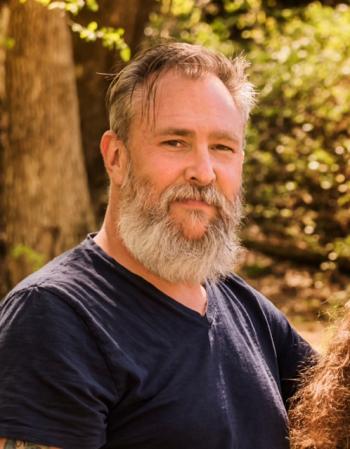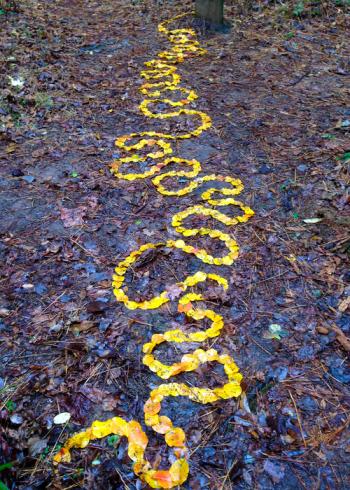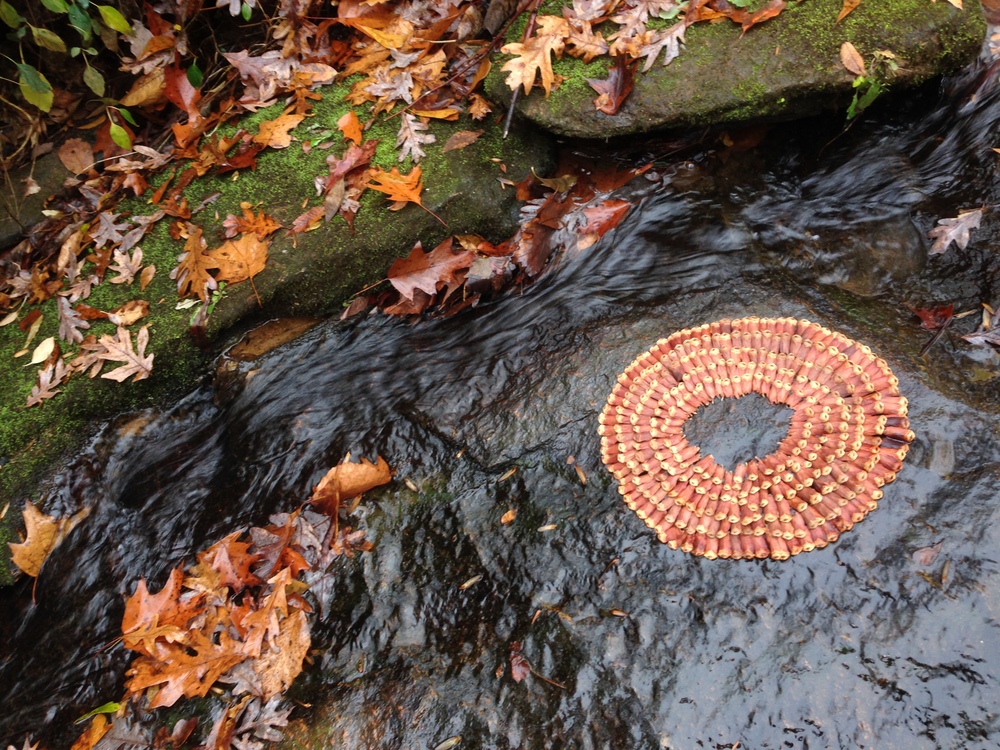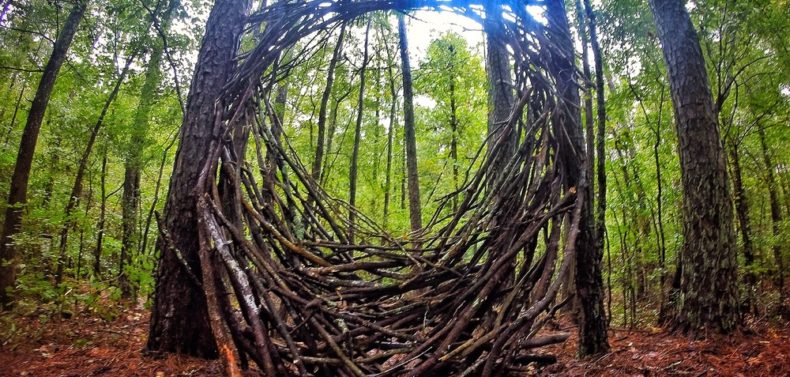If you’ve ever taken a walk and come across a perfectly arranged color gradient of oak leaves, a mandala of delicate flower petals, a weaving zig-zag of smooth stones or a giant nest of branches, you may have discovered the work of local land artist and teacher Chris Taylor. A longtime graphic artist and active musician who can be found playing drums with the Classic City Dance Band, Taylor’s own introduction to land art came a few years ago through watching Rivers and Tides, a documentary about British artist and environmentalist Andy Goldsworthy, one of the most prominent forces behind site-specific installations within natural and urban settings.

Chris Taylor
“His work essentially legitimized what I had been doing since I was a kid: playing with sticks,” says Taylor. “I started playing more and more, then started working with students at my daughter’s elementary school as a means of introducing them to nature, and as a way of self-expression for students who may not have access to art supplies or other materials.”
Taylor documents his installations through photographs, which are compiled under the moniker 34 Degrees North (34north.org), named for the approximate latitude of his hometown, Blue Ridge. Located near the northern tip of Georgia, right at the Southern end of the Appalachians, it’s a diverse and inspirational landscape full of mountains, lakes and streams perfect for exploring.
“My aesthetic and use of resources is shaped greatly by the people of the mountains, a culture rich in traditions of using what they had to work with,” says Taylor.
It’s fitting that someone who spent a good part of his childhood playing in the forests would grow up to create site-specific artworks within the environment. Assembling found materials into patterns or sculptures focused on color and shape—essentially creating something out of nothing—speaks to the resourcefulness of Appalachian culture.
“When teaching, I have students follow a process: explore, collect, curate and create. It’s how I work,” says Taylor. “I go to a place, get a feel for it, see what’s available and hopefully create something that mimics or fits in with the environment. I have forms in my head all the time, so sometimes I try one, or just see where the space takes me.”
One of Taylor’s most intensive projects so far has been the “Garden Nests,” a series of giant nests scattered along the walking trails at the State Botanical Garden of Georgia. Stumbling upon one is mysterious and almost alarming—how ginormous of a bird could possibly reside in a home so huge? Each is wide enough for a human to stand in (or eat lunch and take a nap, as the artist has been told before), and invites walkers to stop, wonder and play awhile.
“The process was designed to mimic creating a home. Athens is home to a population that changes every year. Not only students, but teachers, artists, musicians and others come to Athens and create lives using the resources available locally,” says Taylor. “If they move on, then another soul occupies that space allowing Athens an environment full of diverse, wonderful people. Birds do the same.”
Constructed semi-weekly over the course of nine months, the 24 “Garden Nests” were assembled using pre-cut, cleared or fallen wood and limbs. For anyone hoping to scout out each one, a map of locations is available online. A separate series of sculptures equally worthy of finding are “The Gates” at Sandy Creek Nature Center, which appear as vertically oriented hoops. Nearly mystical in their otherworldly portal appearance, “The Gates” challenged their designer to use balance and tension to get the pieces of wood to stay in place.

The month of October alone was an impressive demonstration of the artist’s wide range of abilities and ongoing experimentation with different materials. For Ciné, he constructed a large Wicker Man in celebration of Halloween and the cinema’s horror film series, Son of Schlocktober fest. During Transpectacle, an outdoor festival featuring live painting, music and an artist market, he built a sculpture on-site using plastic repurposed from water bottles. For the “Wild Rumpus Art Show” at Creature Comforts, he contributed an abstract spectrogram painting inspired by the echolocation of bats.
“Land art is inherently about form, using balance, contrast and shape to convey its message. However, it can be difficult to speak of emotion,” he says. “I found that I was craving color, which led me to painting and working with yarn and textiles. I am able to use my technique of layering to create my message with both paint and yarn effectively. I find myself painting more and more.”
Taylor has worked as a graphic artist for over 20 years, designing everything from magazine layouts to band posters to book covers, and was the art director for the Terry College of Business for 17 years. This past January, he left his career at UGA to pursue art and teaching full-time. He currently visits Double Helix twice a week to teach about graphic design and land art, and leads an after-school program once a week at Oglethorpe Avenue Elementary. In the past, he’s also taught workshops at the Athens Community Council on Aging and Little Rose Nature School at the Lyndon House Arts Center.
“What I do, anyone can do. It’s why I love teaching—I’m giving permission to create out of thin air. It doesn’t have to be perfect, it just has to be you,” he says. “I’ve been given a great opportunity to work with and teach children of some of the best artists in Athens. If I thought about it too much, I’d be terrified. But when I hear from someone that their kids enjoyed working with me, well, that’s one of the best feels ever.”
Given the impermanent nature of his chosen medium—components are subject to the elements, as well as natural decay—the best way to follow Taylor’s work is through social media. Exploring through his archives is a wonderful way to observe the diversity of flora, but is no replacement for experiencing it in person. His artwork not only captures the simple and serene beauty readily accessible among the changing colors, unusual textures and recurring patterns in nature, but encourages viewers to go discover their own connection.
“My hope is to foster a sense of wonder at being outside, to notice the details, to be in the moment and have fun. Play is important for everyone.”

Like what you just read? Support Flagpole by making a donation today. Every dollar you give helps fund our ongoing mission to provide Athens with quality, independent journalism.










